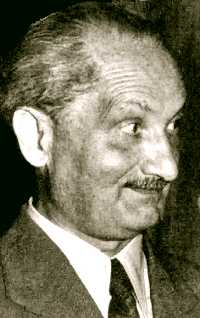 I have been trying to think of my fond relationship with phenomenology. What, over the years, has brought me so close to it? Or, what uses--to put it a more practical way--have I been able to make out of it? And where do I stand with relationship to its particular problems? And which practitioner of phenomenology do I find most productive for me?
I have been trying to think of my fond relationship with phenomenology. What, over the years, has brought me so close to it? Or, what uses--to put it a more practical way--have I been able to make out of it? And where do I stand with relationship to its particular problems? And which practitioner of phenomenology do I find most productive for me?I first came to phenomenology through work on philosophy of mind--the mind body-problem specifically. What intrigued me most here, though, was more the misfires of the mind when it has input from the body than the more traditional (and difficult) problem of establishing the fact of this input. Perception occurred for me pretty unproblematically. Thus the qualia problem never really interested me (though you might expect that it would). I felt it was just a problem about how we talk about what is represented to us: it was still too connected with problems of establishing that perception occured. I still think that what interests people about qualia is not the qualia themselves, but what it does to a theory of mind. However, what intrigued me at the time was precisely this--what was perceived, the actual forms perceptions themselves took. So the way into this was looking at the stuff we could perceive that was not so cleanly perceived. Definite perceptions, definite input from the body to the mind, but not so definite in terms of its content--not because it remains irreducible to a theory of perception (in positive terms, completely full of qualitative content) but because the content itself is one of discrepancy between the perception and how perception usually works.
So you can see an interest in the anticipatory powers of the bodily schema coming into play--the eventual form that this interest would take. This I picked up in full force with the help of one of my professors, Arthur Melnick, who pursues his Kantian problems with the aid of phenomenology--especially Merleau-Ponty, whose conception of phenomenology remains closest to me, even now, and whose work (I should just note this) colors pretty much everything I will say on the subject here, even when (as I will) I go and look at Husserl. But what is important is that here, in the transit between this initial interest and the eventual fully-fledged phenomenological form of my study, was the first use of phenomenology that I really discerned: it is a sort of thing that can fill out what a language focused roughly on the general form of perception (whether this articulates itself in terms of mind-body input, or, as was the case for Melnick, in terms of Kantian intuition) with more specific concerns about what happens when this general schema can't account for something. To put it a better way, phenomenology picks up this moment in the failure of a general account of mental life not as a "problem," as the phil-mind people take it up, but as the starting point of its analysis. More simply put, failures in perception are precisely indicators as to the fullness of experience itself for phenomenology, because phenomenology is focused on the content of experiences not as just a general stuffing for form, but as distinct instances that have the power to make the usual working of perception take a singular detour. The most extreme way of putting this (and I do so by using all these terms less technically) would be to say that, to a degree, phenomenology allows for experiential content to make the form of its own perception. Or, in even more plain and less burdened language: phenomenology allows for something in experience to cohere such that it generates thereby the terms of its own coherence. (This is largely because what I am describing here is simply the reduction: to take up, theoretically, a "failure" is the beginning of a suspension of the natural attitude.)
However I explain this, what's clear is that this quality makes phenomenology fall into places where more formal theories of perception just don't have anything to say--or, quite frankly, don't want to say anything. Though its aims are much more lofty (and problematic, as its goal is nothing less than the complete reappropriation of this sphere to philosophy), this often makes it work a bit a posteriori, almost a bit empirically, without being beholden to the oppositions these two terms usually enter into. There is a story that someone came up to Sartre who was eating something like an ice cream, and told him with phenomenology he could describe the ice cream--this is what got him exited about it. For me it was very similar, though without the more militant desire to oppose this sort of everyday reality to the high philosophies. If one goes too far with this way of looking at it, one easily makes the mistake (and it is often made by those who don't know phenomenology but want to criticize it) of thinking that phenomenology is a going back to the self-evident, the common sense, the ordinary, when (see Husserl, Ideas I §32) what is at stake is the making-scientific or theoretical of the assumption of self-evidence, an estrangement that brings something like the eating of the ice cream into the theoretical. So, without this militant edge, for me, what is important is the more basic fact that phenomenology can begin to rigorously investigate as completely normal what other theories consider aberrant.
As I said, I took up interest in the body, and this was mostly because that is where a lot of these "aberrations" in perceived or experienced content took place: the double-touch, tricks of perspective due to one's bodily stance, afterimages and the structure of the eye etc. etc. But as you can see, the interest began to take the form of wondering what was special about the phenomenon that it could fall into this particular place all the time--as I said, what was special to me was the forming power of the phenomenological content, or its sort of self-generating coherence, even if it is an aberrant perception. I'll pick this up next time as it took the form of a meditation on finitude, helped by Heidegger (then on to non-phenomena, like writing). This will lead us to another use of phenomenology, one that will emerge from what I am talking about here, which is essentially what Husserl calls "immanence," and moving towards the being of the phenomenon itself--the fact that (and this is really what "immanence" is about for Husserl) its own limit is its condition for emergence.








